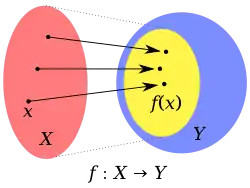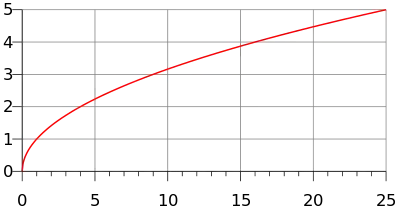Domain of a function
In mathematics, the domain of a function is the set of inputs accepted by the function. It is sometimes denoted by or , where f is the function.


More precisely, given a function , the domain of f is X. Note that in modern mathematical language, the domain is part of the definition of a function rather than a property of it.
In the special case that X and Y are both subsets of , the function f can be graphed in the Cartesian coordinate system. In this case, the domain is represented on the x-axis of the graph, as the projection of the graph of the function onto the x-axis.
For a function , the set Y is called the codomain, and the set of values attained by the function (which is a subset of Y) is called its range or image.
Any function can be restricted to a subset of its domain. The restriction of to , where , is written as .
Natural domain
If a real function f is given by a formula, it may be not defined for some values of the variable. In this case, it is a partial function, and the set of real numbers on which the formula can be evaluated to a real number is called the natural domain or domain of definition of f. In many contexts, a partial function is called simply a function, and its natural domain is called simply its domain.
Examples
- The function defined by cannot be evaluated at 0. Therefore the natural domain of is the set of real numbers excluding 0, which can be denoted by or .
- The piecewise function defined by has as its natural domain the set of real numbers.
- The square root function has as its natural domain the set of non-negative real numbers, which can be denoted by , the interval , or .
- The tangent function, denoted , has as its natural domain the set of all real numbers which are not of the form for some integer , which can be written as .
Other uses
The word "domain" is used with other related meanings in some areas of mathematics. In topology, a domain is a connected open set.[1] In real and complex analysis, a domain is an open connected subset of a real or complex vector space. In the study of partial differential equations, a domain is the open connected subset of the Euclidean space where a problem is posed (i.e., where the unknown function(s) are defined).
Set theoretical notions
For example, it is sometimes convenient in set theory to permit the domain of a function to be a proper class X, in which case there is formally no such thing as a triple (X, Y, G). With such a definition, functions do not have a domain, although some authors still use it informally after introducing a function in the form f: X → Y.[2]
See also
- Attribute domain
- Bijection, injection and surjection
- Codomain
- Domain decomposition
- Effective domain
- Image (mathematics)
- Lipschitz domain
- Naive set theory
- Support (mathematics)
Notes
- Weisstein, Eric W. "Domain". mathworld.wolfram.com. Retrieved 2020-08-28.
- Eccles 1997, p. 91 (quote 1, quote 2); Mac Lane 1998, p. 8; Mac Lane, in Scott & Jech 1967, p. 232; Sharma 2004, p. 91; Stewart & Tall 1977, p. 89
References
- Bourbaki, Nicolas (1970). Théorie des ensembles. Éléments de mathématique. Springer. ISBN 9783540340348.